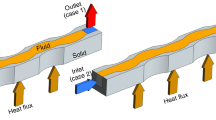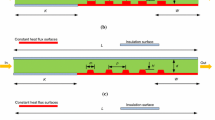Abstract
In this paper, we present a numerical simulation of a laminar, steady and Newtonian flow of f-graphene nanoplatelet/water nanofluid in a new microchannel design with factors for increasing heat transfer such as presence of ribs, curves to enable satisfactory fluid mixing and changing fluid course at the inlet and exit sections. The results of this study show that Nusselt number is dependent on nanoparticles concentration, inlet geometry and Reynolds number. As the nanofluid concentration increases from 0 to 0.1% and Reynolds number from 50 to 1000, the Nusselt number enhances nearly up to 3% for increase in fluid concentration and averagely from 15.45 to 54.1 and from 14.5 to 55.9 for geometry with and without rectangular rib, respectively. The presence of ribs in the middle section of microchannel and curves close to hot walls causes a complete mixing of the fluid in different zones. When the nanoparticles concentration is increased, the pressure drop and velocity gradient will become higher. An increased concentration of nanoparticles in contribution with higher Reynolds numbers only increases the fraction factor slightly. (The fraction factor increases nearly 37% and 35% for Re = 50 and 1000, respectively.) The highest uniform temperature distribution can be found in the first zones of fluid in the microchannel and by further movement of fluid toward exit section, because of decreasing difference between surface and fluid temperature, the growth of temperature boundary layer increases and results in non-uniformity in temperature distribution in microchannel and cooling fluid. With decrease in the concentration from 0 to 0.1%, the average outlet temperature and FOM decrease nearby 0.62% and 6.15, respectively.












Similar content being viewed by others
Abbreviations
- A :
-
Area (m2)
- C p :
-
Heat capacity (J kg−1 K−1)
- D :
-
Hydraulic diameter (m)
- f :
-
Friction factor
- H :
-
Heat transfer coefficient (W m−2 K)
- H a :
-
Depth of the dimple (m)
- H f :
-
Exit sections in horizontal fashion (m)
- H s :
-
Height of microchannel (μm)
- k :
-
Thermal conductivity coefficient (W m−1 K−1)
- L a :
-
Length of the dimple (μm)
- L in :
-
Length of exit (μm)
- L t :
-
Length of microchannel (μm)
- Nu :
-
Nusselt number
- P :
-
Fluid pressure (Pa)
- p :
-
Perimeter (μm)
- Pp:
-
Pumping power (W)
- Pr :
-
Prandtl number
- q″:
-
Surface heat flux (W m−2)
- Re :
-
Reynolds number
- T :
-
Temperature (K)
- u, v, w :
-
Velocity components in x, y and z directions (m s−1)
- W f :
-
Width of inlet (μm)
- W s :
-
Microchannel silicon thickness (μm)
- x, y, z :
-
Cartesian coordinates
- Δ :
-
Difference
- α :
-
Thermal diffusivity (m2 s−1)
- μ :
-
Dynamic viscosity (Pa s)
- ρ :
-
Density (kg m−3)
- υ :
-
Kinematics viscosity (m2 s−1)
- Ave:
-
Average
- f:
-
Base fluid (distilled water)
- In:
-
Inlet
- m:
-
Main
- Out:
-
Outlet
- S:
-
Surface
- Wt:
-
Mass fraction
References
Nadaraja D, Kamaruzaman N, Abidin U, Mohd Sies M (2019) Experimental study on the effect of multilayer microchannel arrangement to the thermal hydraulic performance of microchannel arrays. J Adv Res Fluid Mech Therm Sci Issue 1:23–31
Rezaei O, Akbari OA, Marzban A, Toghraie D, Pourfattah F, Mashayekhi R (2017) The numerical investigation of heat transfer and pressure drop of turbulent flow in a triangular microchannel. Physica E 93:179–189
Zuo J-W, Wong K-C, Ng HK (2019) Heat transfer network and correlation for a double-layered microchannel heat sink. J Adv Res Fluid Mech Therm Sci 56(1):88–99
Shamsi MR, Akbari OA, Marzban A, Toghraie D, Mashayekhi R (2017) Increasing heat transfer of non-Newtonian nanofluid in rectangular microchannel with triangular ribs. Physica E 93:167–178
Sarlak R, Yousefzadeh S, Akbari OA, Toghraie D, Sarlak S (2017) The investigation of simultaneous heat transfer of water/Al2O3 nanofluid in a close enclosure by applying homogeneous magnetic field. Int J Mech Sci 133:674–688
Gholami MR, Akbari OA, Marzban A, Toghraie D, Shabani GAS, Zarringhalam M (2018) The effect of rib shape on the behavior of laminar flow of oil/MWCNT nanofluid in a rectangular microchannel. J Therm Anal Calorim. https://doi.org/10.1007/s10973-017-6902-3
Hosseinnezhad R, Akbari OA, Afrouzi HH, Biglarian M, Koveiti A, Toghraie D (2018) Numerical study of turbulent nanofluid heat transfer in a tubular heat exchanger with twin twisted-tape inserts. J Therm Anal Calorim 132(1):741–759
Akbari OA, Karimipour A, Toghraie Semiromi D, Safaei MR, Alipour H, Goodarzi M, Dahari M (2016) Investigation of rib’s height effect on heat transfer and flow parameters of laminar water–Al2O3 nanofluid in a two dimensional rib-microchannel. Appl Math Comput 290:135–153
Akbari OA, Toghraie D, Karimipour A (2015) Impact of ribs on flow parameters and laminar heat transfer of water–aluminum oxide nanofluid with different nanoparticle volume fractions in a three-dimensional rectangular microchannel. Adv Mech Eng 7(11):1–11
Karimipour A, Alipour H, Akbari OA, Toghraie Semiromi D, Hemat Esfe M (2015) Studying the effect of indentation on flow parameters and slow heat transfer of water–silver nanofluid with varying volume fraction in a rectangular two-dimensional microchannel. Ind J Sci Technol 8(15):51707
Gravndyan Q, Akbari OA, Toghraie D, Marzban A, Mashayekhi R, Karimi R, Pourfattah F (2017) The effect of aspect ratios of rib on the heat transfer and laminar water/TiO2 nanofluid flow in a two-dimensional rectangular microchannel. J Mol Liq 236:254–265
Bhattacharya P, Samanta AN, Chakraborty S (2009) Numerical study of conjugate heat transfer in rectangular microchannel heat sink with Al2O3/H2O nanofluid. Heat Mass Transf 45:1323–1333
He Y, Mena Y, Zhao Y, Lu H, Ding Y (2009) Numerical investigation into the convective heat transfer of TiO2 nanofluids flowing through a straight tube under the laminar flow conditions. Appl Therm Eng 29:1965–1972
Farsad E, Abbasi SP, Zabihi MS, Sabbaghzadeh J (2011) Numerical simulation of heat transfer in a micro channel heat sinks using nanofluids. Heat Mass Transf 47:479–490
Manca O, Nardini S, Ricci D (2012) A numerical study of nanofluid forced convection in ribbed channels. Appl Therm Eng 37:280–292
Mohamad Noh NH, Fazeli A, Che Sidik NA (2014) Numerical simulation of nanofluids for cooling efficiency in microchannel heat sink. J Adv Res Fluid Mech Therm Sci 4(1):13–23
Akbari OA, Toghraie D, Karimipour A (2016) Numerical simulation of heat transfer and turbulent flow of water nanofluids copper oxide in rectangular microchannel with semi-attached rib. Adv Mech Eng 8(4):1–25
Wang H, Chen Z, Gao J (2016) Influence of geometric parameters on flow and heat transfer performance of micro-channel heat sinks. Appl Therm Eng 107:870–879
Wu J, Zhao J, Lei J, Liu B (2016) Effectiveness of nanofluid on improving the performance of microchannel heat sink. Appl Therm Eng 101:402–412
Sheikhalipour T, Abbassi A (2016) Numerical investigation of nanofluid heat transfer inside trapezoidal microchannels using a novel dispersion model. Adv Powder Technol 27:1464–1472
Toghraie D, Abdollah MMD, Pourfattah F, Akbari OA, Ruhani B (2018) Numerical investigation of flow and heat transfer characteristics in smooth, sinusoidal and zigzag-shaped microchannel with and without nanofluid. J Therm Anal Calorim. https://doi.org/10.1007/s10973-017-6624-6
Alipour H, Karimipour A, Safaei MR, Semiromi DT, Akbari OA (2017) Influence of T-semi attached rib on turbulent flow and heat transfer parameters of a silver–water nanofluid with different volume fractions in a three-dimensional trapezoidal microchannel. Physica E 88:60–76
Parsaiemehr M, Pourfattah F, Akbari OA, Toghraie D, Sheikhzadeh G (2018) Turbulent flow and heat transfer of water/Al2O3 nanofluid inside a rectangular ribbed channel. Physica E 96:73–84
Yu XF, Zhang CP, Teng JT, Huang SY, Jin SP, Lian YF et al (2012) A study on the hydraulic and thermal characteristics in fractal tree-like microchannels by numerical and experimental methods. Int J Heat Mass Transf 55:7499–7507
Leng C, Wang XD, Wang TH, Yan WM (2015) Fluid flow and heat transfer in microchannel heat sink based on porous fin design concept. Int Commun Heat Mass Transf 65:52–57
Normah GM, Oh JT, Chien NB, Choi KI, Robiah A (2015) Comparison of the optimized thermal performance of square and circular ammonia-cooled microchannel heat sink with genetic algorithm. Energy Convers Manag 102:59–65
Wong KC, Lee JH (2015) Investigation of thermal performance of microchannel heat sink with triangular ribs in the transverse microchambers. Int Commun Heat Mass Transf 65:103–110
Chu JC, Teng JT, Greif AR (2008) Heat transfer for water flow in triangular silicon microchannels. J Therm Sci Technol 3:410–420
Xie G, Shen H, Wang CC (2015) Parametric study on thermal performance of microchannel heat sinks with internal vertical Y-shaped bifurcations. Int J Heat Mass Transf 90:948–958
Rajabifar B (2015) Enhancement of the performance of a double layered microchannel heatsink using PCM slurry and nanofluid coolants. Int J Heat Mass Transf 88:627–635
Wu JM, Zhao JY, Tseng KJ (2014) Parametric study on the performance of double-layered microchannels heat sink. Energy Convers Manag 80:550–560
Tran N, Chang YJ, Teng JT, Dang T, Greif R (2016) Enhancement thermodynamic performance of microchannel heat sink by using a novel multi-nozzle structure. Int J Heat Mass Transf 101:656–666
Rajabi Far B, Mohammadian SK, Khanna SK, Zhang Y (2015) Effects of pin tip-clearance on the performance of an enhanced microchannel heat sink with oblique fins and phase change material slurry. Int J Heat Mass Transf 83:136–145
Safaei MR, Goodarzi M, Akbari OA, Safdari Shadloo M, Dahari M (2016) Performance evaluation of nanofluids in an inclined ribbed microchannel for electronic cooling applications. In: Sohel Murshed SM (ed) Electronics cooling. InTech, Rijeka. https://dx.doi.org/10.5772/62898. http://www.intechopen.com/books/electronics-cooling/performance-evaluation-of-nanofluids-in-aninclined-ribbed-microchannel-for-electronic-cooling-appli
Arani AAA, Akbari OA, Safaei MR, Marzban A, Alrashed AAAA, Ahmadi GR, Nguyen TK (2017) Heat transfer improvement of water/single-wall carbon nanotubes (SWCNT) nanofluid in a novel design of a truncated double layered microchannel heat sink. Int J Heat Mass Transf 113:780–795
Yarmand H, Gharehkhani S, Shirazi SFS, Amiri A, Alehashem MS, Dahari M, Kazi SN (2016) Experimental investigation of thermo-physical properties, convective heat transfer and pressure drop of functionalized graphene nanoplatelets aqueous nanofluid in a square heated pipe. Energy Convers Manag 114:38–49
Wang G-L, Yang D-W, Wang Y, Niu D, Zhao X-L, Ding G-F (2015) Heat transfer and friction characteristics of the microfluidic heat sink with variously-shaped ribs for chip cooling. Sensors 15(4):9547–9562
Arabpour A, Karimipour A, Toghraie D, Akbari OA (2018) Investigation into the effects of slip boundary condition on nanofluid flow in a double-layer microchannel. J Therm Anal Calorim 131(3):2975–2991
Karbasifar B, Akbari M, Toghraie D (2018) mixed convection of Water-Aluminum oxide nanofluid in an inclined lid-driven cavity containing a hot elliptical centric cylinder. Int J Heat Mass Transf 116(1):1237–1249
Acknowledgements
The authors would like to express their special thanks for the provided funding resources by Mohsen Saffari Pour from the National Elite Foundation of Iran and Stiftelsen Axel Hultgerns of Sweden for supporting this research.
Author information
Authors and Affiliations
Corresponding author
Additional information
Technical Editor: Daniel Onofre de Almeida Cruz, D.Sc.
Publisher's Note
Springer Nature remains neutral with regard to jurisdictional claims in published maps and institutional affiliations.
Rights and permissions
About this article
Cite this article
Khodabandeh, E., Akbari, O.A., Toghraie, D. et al. Numerical investigation of thermal performance augmentation of nanofluid flow in microchannel heat sinks by using of novel nozzle structure: sinusoidal cavities and rectangular ribs. J Braz. Soc. Mech. Sci. Eng. 41, 443 (2019). https://doi.org/10.1007/s40430-019-1952-z
Received:
Accepted:
Published:
DOI: https://doi.org/10.1007/s40430-019-1952-z




